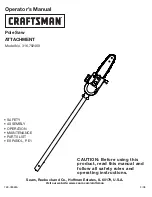
IMPORTANT SAFETY INSTRUCTIONS
15. USE EYE PROTECTION.
Use a full-face mask
if the work you’re doing
produces metal filings, dust or wood chips.
Goggles are acceptable in other
situations. Wear a clean dust mask if the work involves creating a lot of fine
or coarse dust.
16. SECURE WORK.
Use clamps or a vise to hold the work, this frees both
hands to operate the tool.
17. DON’T OVERREACH.
Keep proper footing and balance at all times. Do not
reach over or across machines that are running.
18. MAINTAIN TOOLS.
Keep tools sharp and clean for better and safer
performance. Follow instructions for lubricating and changing accessories.
For safe performance. Keep handles dry, clean and free from oil and grease.
19. AVOID UNINTENTIONAL STARTING.
Be sure the switch is in the
OFF
posi
-
tion before plugging in.
20. ALWAYS CHECK AND MAKE SURE TO REMOVE ANY ADJUSTING KEYS
OR WRENCHES
before turning the tool on. Left attached, these parts can fly
off a moving part and result in injury.
21. DO NOT USE THE TOOL IF IT CANNOT BE SWITCHED ON OR OFF.
Have your tool repaired before using it.
22. DISCONNNECT THE PLUG FROM THE POWER SOURCE BEFORE MAKING
ANY ADJUSTMENTS.
Changing attachments or accessories can be dangerous
if the tool could accidentally start.
23. STAY ALERT.
Watch what you are doing & use common sense. Don’t operate
any tool when you are tired.
24. CHECK FOR DAMAGED PARTS.
Before using this tool, any part that is
damaged should be carefully checked to determine that it will operate prop-
erly and perform its intended function. Check for alignment of moving parts,
binding of moving parts, breakage of parts, mountings, and other conditions
that may affect its operation. Inspect screws and tighten any ones that are
loose. Any part that is damaged should be properly repaired or replaced by
an authorized service center unless otherwise indicated elsewhere in the in-
struction manual. Have defective switches replaced by an authorized service
center. Don’t use the tool if switch does not turn it on and off properly.
25. REPLACEMENT PARTS.
When servicing, use only identical replacement
parts.
26. SERVICE AND REPAIRS
should be made by qualified repair technicians at
an authorized repair center. Improperly repaired tools could cause serious
shock or injury.
1.
2.
WOOD ONLY.
The saw is designed for woodcutting only.
3.
DAMAGED OR WARPED SAW BLADES
should not be used. They are out
of balance and could cause further damage to the saw and possible personal
injury.
4.
USE ONLY WITH GUARD IN PLACE.
The guard protects the operator
from cutting debris as well as from broken pieces of the blade, should it break
in use.
5.
REPLACE THE TABLE INSERT WHEN WORN.
Excessive tear-out increases
the likelihood of injury from flying debris. When setting the saw at a new angle,
check that the blade does not cut into the table insert, rear fence, or another
part of your saw.
6.
ALWAYS USE THE BLADE WRENCH
to tighten the saw blade onto the arbor.
7.
CONNECT YOUR MITER SAW TO A DUST COLLECTING DEVICE
if pos-
sible. If not, use the dust bag that comes with the tool and empty it regularly.
USE A SAWBLADE SUITED TO THE CUTTING JOB AND MATERIAL TO BE
CUT.
SAFETY PRECAUTIONS FOR COMPOUND MITER SAW



























